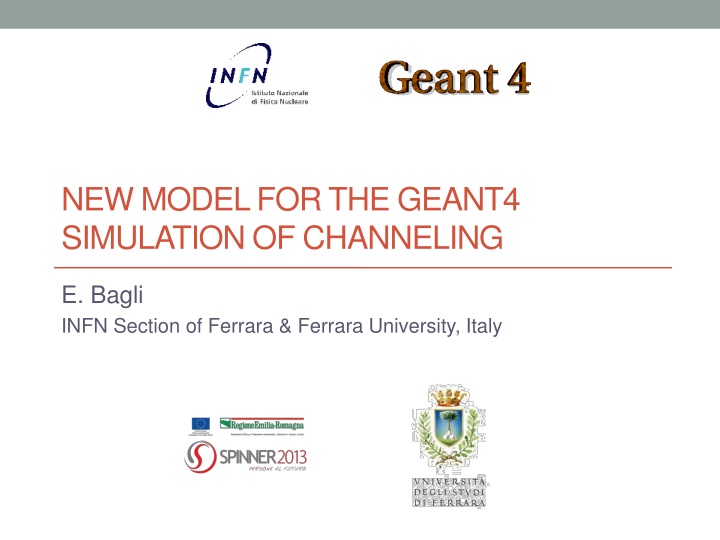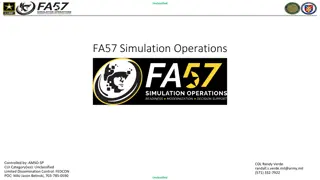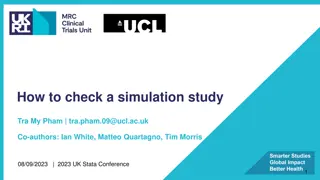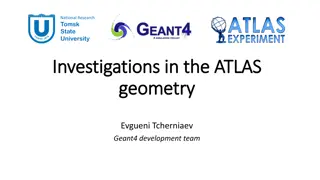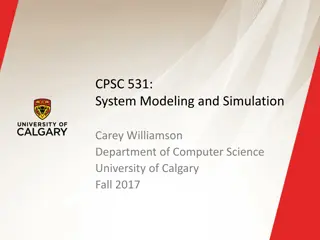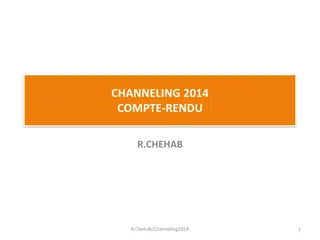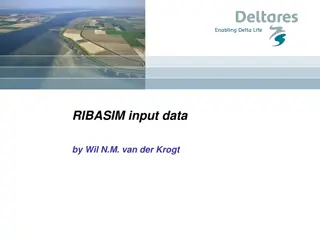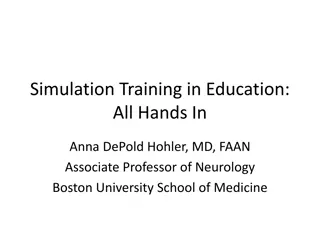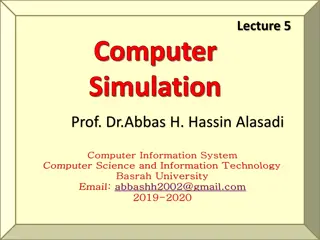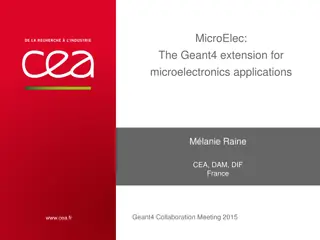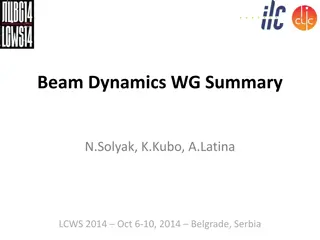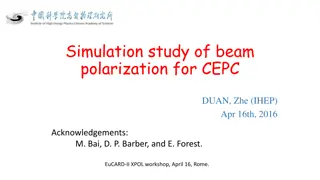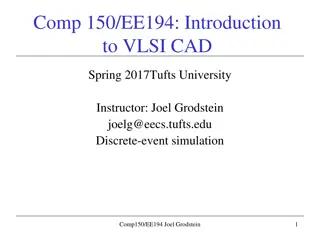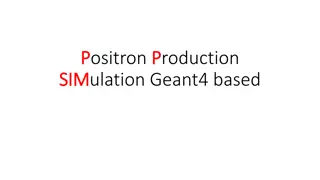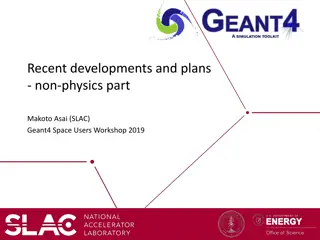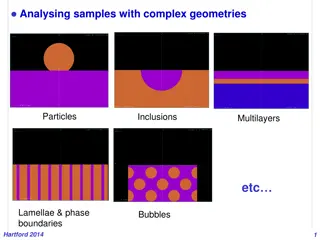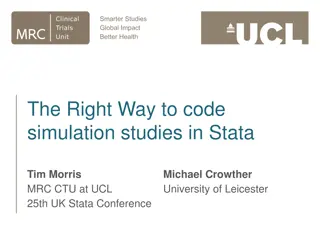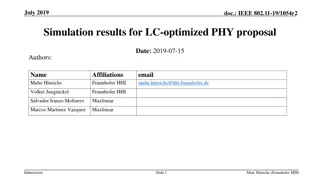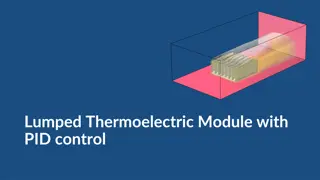NEW MODEL FOR THE GEANT4 SIMULATION OF CHANNELING
Constructed for the simulation of particle channeling, this advanced Geant4 model enhances the understanding of charged particle interactions within crystal structures. It features a unique approach that aligns particle momentum with crystal planes, modifying density & biasing techniques for accurate simulations. The model's focus lies on trajectory manipulation, crystal structure definition, and conditions for particle channeling, ensuring precise outcomes in crystal-amorphous systems.
Download Presentation

Please find below an Image/Link to download the presentation.
The content on the website is provided AS IS for your information and personal use only. It may not be sold, licensed, or shared on other websites without obtaining consent from the author.If you encounter any issues during the download, it is possible that the publisher has removed the file from their server.
You are allowed to download the files provided on this website for personal or commercial use, subject to the condition that they are used lawfully. All files are the property of their respective owners.
The content on the website is provided AS IS for your information and personal use only. It may not be sold, licensed, or shared on other websites without obtaining consent from the author.
E N D
Presentation Transcript
NEW MODEL FOR THE GEANT4 SIMULATION OF CHANNELING E. Bagli INFN Section of Ferrara & Ferrara University, Italy
Charged Particle Interaction Crystal Amorphous
Geant4 Current Approach 1. The particle initial transverse energy is computed at the entrance of the crystal. This is the only information stored. 2. At each step, which can be limited by the other Geant4 processes, the variation of transverse energy is computed. 3. If the particle is still under channeling, the momentum of the particle is aligned with the crystal planes, otherwise the particle leaves the channeling state and the momentum direction varies. 4. Under channeling, a modified value of nuclei and electron density is passed to the Geant4 processes via the biasing technique.
Geant4 processes modification Check If Volume Is a Crystal By modifying the trajectory of the particle and the density of the material seen by the particle the orientational effects in a crystal affect all the Geant4 physical process. Check If Particle Is Under Channeling/VR The trajectories of channeled particles are forced to be tangent to crystal curvature. Channeling Process The density of materials seen by the channeled particles depends on transverse energy of the particles. Particle Trajectory Manipulation Material Density Modification
Crystal Crystal The crystal object is built adding to the standard Physical Volume the Crystal Structure in which the Unit Cell and the Lattice are defined. Physical Volume Crystal Structure Logical Volume Unit cell Lattice Solid
Crystal Crystal The crystal object is built adding to the standard Physical Volume the Crystal Structure in which the Unit Cell and the Lattice are defined. Physical Volume Crystal Structure Logical Volume Unit cell Lattice Not implemented in standard Geant4 kernel Solid Standard Geant4 kernel
Condition for channeling Straight crystal ET<Umax Bent crystal ET '<Umax ' '=pb ET=pb q2+U'(x) q2+U(x) ET 2 2
Modified density Before the simulation starts, the table of the average density ratio vs. the transverse energy is computed or loaded. The path is integrated over one oscillation period. Penetration Depth Impact Position
Modified density Straight crystal Density Ratio Depending on the transverse energy of the particle, the density seen is different
Modified density Nuclei and electron density tables are stored for positive and negative particles. This approach can be used for crystal with dimension parallel to the beam much longer than the channeling oscillation period.
Geant4 processes Discrete processes Continuous processes The mean free path of the discrete processes is recomputed at each step using the modified density because it is directly proportional to the density ( ) of the material. Material density ( ) for the calculation of continuous energy loss (dE/dx) is modified at each step (dx= dz) to enable the reduction or the enhancement of the energy loss due to channeling.
Modified density Geant4 Mean Free Path Modification Density Ratio (@20 eV) Density Ratio = 1.5 (@15 eV) Density Ratio = 0.8 Depending on the transverse energy of the particle, the density seen is different
Modified density For negative particles the ratio is always higher than unity. Thus, the particles interact more frequently with nuclei and electrons in a crystal under coherent effects than in an amorphous media with the same average atomic density.
Geant4 implementation Current Features Only transverse energy variation tracked. No information on exact position and momentum. Longer step (Faster) than full numerical solution of equation of motion.
Geant4 implementation Current New
Geant4 implementation Possible features New Maintain current implementation of: Modification of Geant4 process cross-section. Crystal classes. Between each step solve exact trajectory. Possibility to estimate: Coherent radiation production. Influence of defects. Undulating structures. Mirror effect. Very slow.
Geant4 Current Approach - Pros Positive and negative particles can be treated with same algorithm. Since the potential well is different and the integrated density varies. The approach allows the estimation of different channeling probability for positive and negative particles. Modification of the cross section of the other phenomena is accounted thanks to the biasing techniques. Such technique is applicable to all the Geant4 physics list via a specific package (M. Verderi work). No limitation on crystal type. Only crystal information needed for the computation of potential and average density. Every particle generated in a Geant4 simulation may experience orientational processes. Thus, variation of shower is length for particle interacting with crystal can be simulated.
Geant4 Current Approach - Cons Because of lack of information on the trajectory some phenomena can not be simulated with current version, e.g., radiation production. outgoing angle is computed via analytical equation depending on particle transverse energy The mixed approach is compatible only with Geant4 Single Scattering models and not with Geant4 Multiple Scattering models. Thus, under channeling, the simulation is slower than standard Geant4 simulation.
Geant4 New Approach Pros/Cons Simulation of full particle trajectory. The current classes can be updated in order to maintain Implementation of crystal structures, which is independent from the channeling process Modification of Geant4 processes cross-section via the biasing technique. Main consequences: Terrible slowing down of the computation. Possible to take into account all the orientational phenomena at high-energies. Computation of the coherent radiation spectrum emitted by particles under coherent effects. Modification of particle trajectory due to the presence of lattice variation, e.g., undulating structure, defects, etc
Coherent radiation in crystal Channeling radiation Coherent Bremsstrahlung Penetration Depth Penetration Depth Impact Position Impact Position
Channeling radiation Channeled particle oscillate between or on atomic planes. The oscillatory motion lead the particle to emit radiation with a defined frequency. The incoherent interaction modify the trajectory and lead the particle to generate photon with different energies. Penetration Depth Impact Position
Coherent Bremsstrahlung The same happens for particles which traverse the crystal with a small angle to the planes, but not under channeling (over-barrier particles) Such particles are repeatedly attracted/repelled by the planes, generating coherent radiation. Penetration Depth Impact Position
Orientational effect in deformed crystals Undulator Mirror Half wavelength Penetration Depth Penetration Depth Impact Position Impact Position
